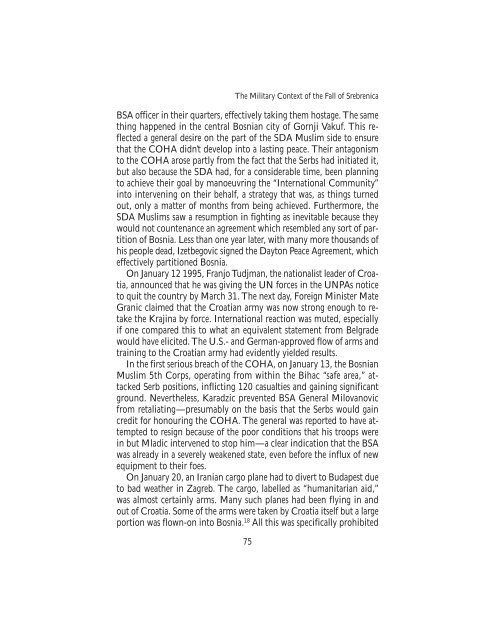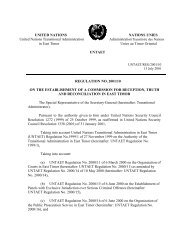The Srebrenica Massacre - Nova Srpska Politicka Misao
The Srebrenica Massacre - Nova Srpska Politicka Misao
The Srebrenica Massacre - Nova Srpska Politicka Misao
You also want an ePaper? Increase the reach of your titles
YUMPU automatically turns print PDFs into web optimized ePapers that Google loves.
<strong>The</strong> Military Context of the Fall of <strong>Srebrenica</strong><br />
BSA officer in their quarters, effectively taking them hostage. <strong>The</strong> same<br />
thing happened in the central Bosnian city of Gornji Vakuf. This reflected<br />
a general desire on the part of the SDA Muslim side to ensure<br />
that the COHA didn’t develop into a lasting peace. <strong>The</strong>ir antagonism<br />
to the COHA arose partly from the fact that the Serbs had initiated it,<br />
but also because the SDA had, for a considerable time, been planning<br />
to achieve their goal by manoeuvring the “International Community”<br />
into intervening on their behalf, a strategy that was, as things turned<br />
out, only a matter of months from being achieved. Furthermore, the<br />
SDA Muslims saw a resumption in fighting as inevitable because they<br />
would not countenance an agreement which resembled any sort of partition<br />
of Bosnia. Less than one year later, with many more thousands of<br />
his people dead, Izetbegovic signed the Dayton Peace Agreement, which<br />
effectively partitioned Bosnia.<br />
On January 12 1995, Franjo Tudjman, the nationalist leader of Croatia,<br />
announced that he was giving the UN forces in the UNPAs notice<br />
to quit the country by March 31. <strong>The</strong> next day, Foreign Minister Mate<br />
Granic claimed that the Croatian army was now strong enough to retake<br />
the Krajina by force. International reaction was muted, especially<br />
if one compared this to what an equivalent statement from Belgrade<br />
would have elicited. <strong>The</strong> U.S.- and German-approved flow of arms and<br />
training to the Croatian army had evidently yielded results.<br />
In the first serious breach of the COHA, on January 13, the Bosnian<br />
Muslim 5th Corps, operating from within the Bihac “safe area,” attacked<br />
Serb positions, inflicting 120 casualties and gaining significant<br />
ground. Nevertheless, Karadzic prevented BSA General Milovanovic<br />
from retaliating—presumably on the basis that the Serbs would gain<br />
credit for honouring the COHA. <strong>The</strong> general was reported to have attempted<br />
to resign because of the poor conditions that his troops were<br />
in but Mladic intervened to stop him—a clear indication that the BSA<br />
was already in a severely weakened state, even before the influx of new<br />
equipment to their foes.<br />
On January 20, an Iranian cargo plane had to divert to Budapest due<br />
to bad weather in Zagreb. <strong>The</strong> cargo, labelled as “humanitarian aid,”<br />
was almost certainly arms. Many such planes had been flying in and<br />
out of Croatia. Some of the arms were taken by Croatia itself but a large<br />
portion was flown-on into Bosnia. 18 All this was specifically prohibited<br />
75



